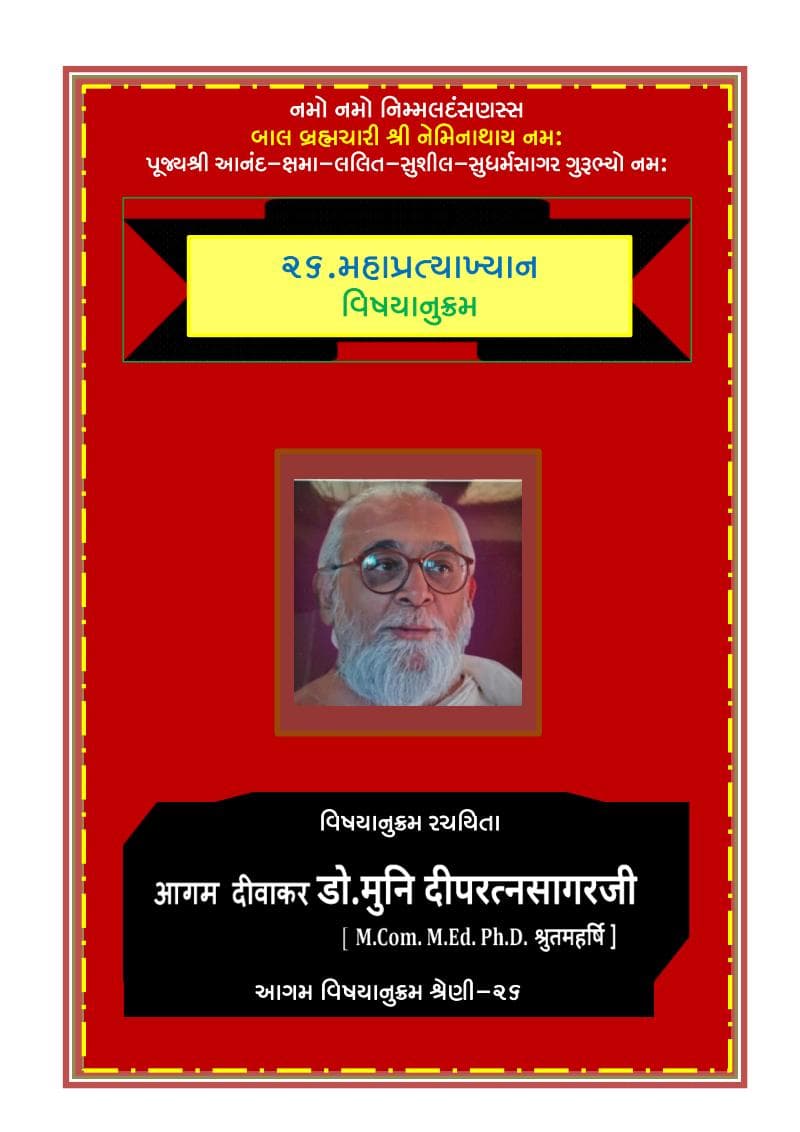26 Maha Pratyakhyan Satik Vishayanukram
Added to library: September 1, 2025

Summary
While I cannot directly access external websites or specific files from links like the one you provided, I can offer a comprehensive summary of what a text titled "26 Maha Pratyakhyan Satik Vishayanukram" likely entails, based on Jain principles and common structures of such works.
General Understanding of the Title:
- "26 Maha Pratyakhyan": This refers to 26 Great Vows (Mahavratas). In Jainism, these are the foundational ethical principles that guide the lives of ascetics (monks and nuns) and are also adopted in a modified form by laypeople. The number 26 suggests a categorization or elaboration of these core vows, possibly into different levels or aspects.
- "Satik": This signifies that the text is commented upon or has an accompanying commentary. Commentaries are crucial in Jain literature, as they explain the nuances, interpretations, and practical applications of the original scriptures.
- "Vishayanukram": This translates to an index of subjects or a table of contents. This indicates that the book is structured to guide the reader through various topics related to the 26 Great Vows.
Likely Content and Structure:
Based on this, "26 Maha Pratyakhyan Satik Vishayanukram" is likely a Jain text that:
- Presents and Explains the 26 Great Vows: It will likely enumerate and provide detailed explanations for each of the 26 Great Vows. These vows are generally derived from the five core Mahavratas for ascetics, which are then expanded upon in various Jain traditions and commentaries.
- Offers a Commentary (Satik): The core of the text would be the commentary, which would delve into:
- The philosophical underpinnings: Explaining the ethical and spiritual reasons behind each vow.
- The practical implications: How these vows are to be observed in daily life by ascetics and, in a modified form, by lay followers.
- The scope and limitations: Clarifying what each vow entails and what actions are prohibited under it.
- The spiritual benefits: Discussing how observing these vows leads to purification of the soul and spiritual progress, ultimately aiming for liberation (Moksha).
- Examples and analogies: Often, commentaries use illustrative stories or analogies to make the concepts more understandable.
- Interconnections: How the various vows relate to and reinforce each other.
- Includes a Subject Index (Vishayanukram): This would serve as a navigational tool, allowing readers to quickly find information on specific vows, concepts, or sections within the commentary. The index would likely list key terms, ethical principles, and classifications of sins or virtues related to the vows.
Key Jain Principles likely discussed in relation to the 26 Maha Pratyakhyan:
The commentary would undoubtedly draw upon fundamental Jain philosophical concepts, including:
- Ahimsa (Non-violence): The cornerstone of Jainism, this would be central to understanding the vows related to harming living beings.
- Aparigraha (Non-possession/Non-attachment): Vows related to limiting possessions, desires, and worldly attachments would be explained in detail.
- Asteya (Non-stealing): This vow, extending beyond mere theft to include any form of unjust acquisition, would be elaborated.
- Brahmacharya (Chastity/Celibacy): For ascetics, this is a strict vow of celibacy, while for laypeople, it involves disciplined control of senses and conduct related to marital fidelity.
- Satya (Truthfulness): Not just speaking the truth, but speaking it in a way that is beneficial and not harmful.
- Karma Theory: The vows are seen as a means to mitigate the accumulation of negative karma and to purify existing karma, leading to spiritual liberation.
- The Three Jewels (Triratna): Right Faith (Samyak Darshan), Right Knowledge (Samyak Gyan), and Right Conduct (Samyak Charitra) are interconnected. The vows are the practical manifestation of Right Conduct, which is essential for the other two.
- The Goal of Moksha: The ultimate aim of observing these vows is to transcend the cycle of birth and death and achieve liberation of the soul.
Purpose of the Text:
The primary purpose of such a book would be to:
- Educate and guide Jain ascetics in their rigorous observance of the Great Vows.
- Provide a deeper understanding of ethical conduct for Jain lay followers.
- Preserve and propagate the teachings of Jainism regarding vows and spiritual discipline.
- Serve as a reference for scholars and practitioners of Jain philosophy.
In essence, "26 Maha Pratyakhyan Satik Vishayanukram" is likely a comprehensive and authoritative guide to the principal ethical commitments in Jainism, explained with detailed commentary and organized for easy reference. It would be a significant text for anyone seeking to understand the core principles of Jain practice and spirituality.